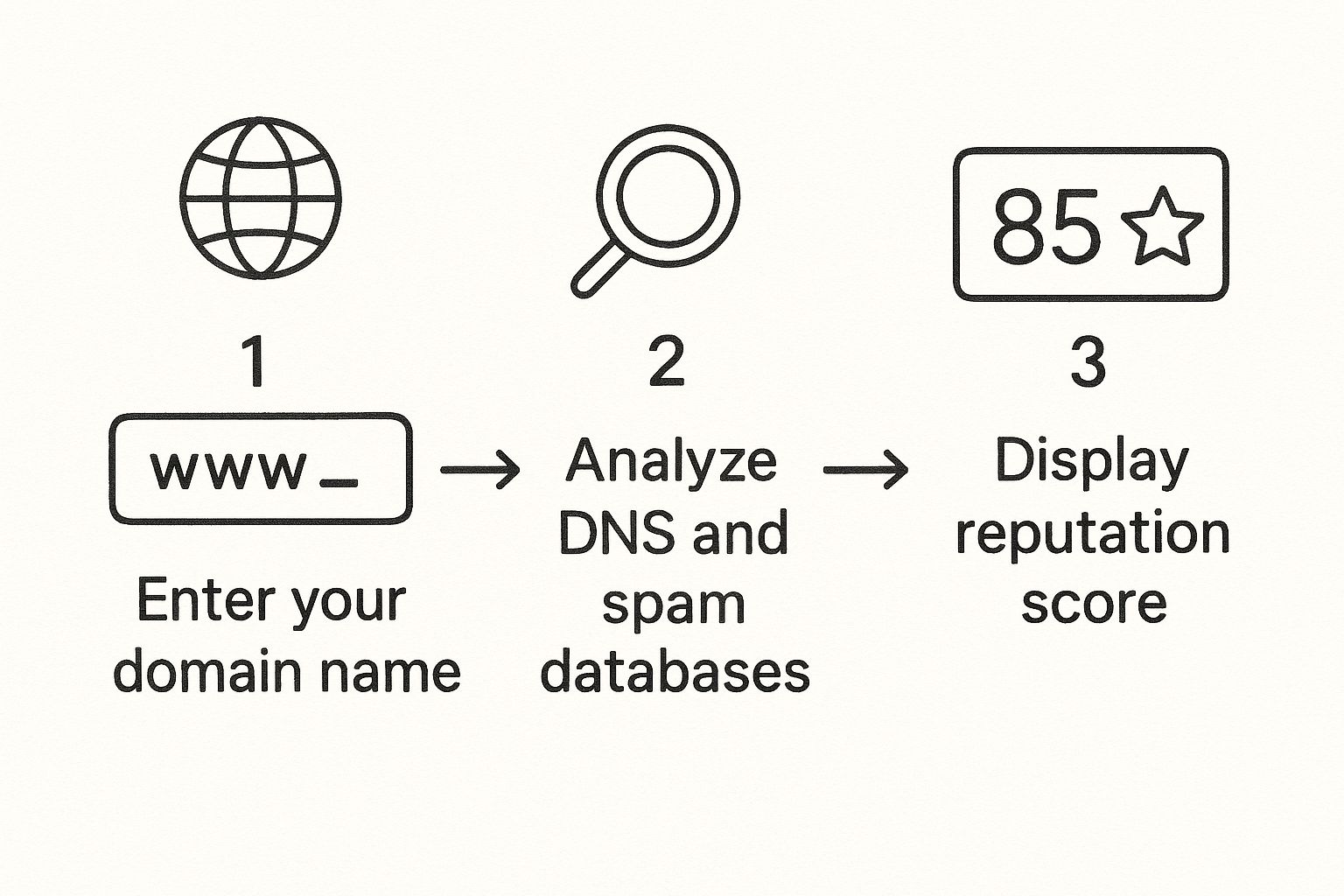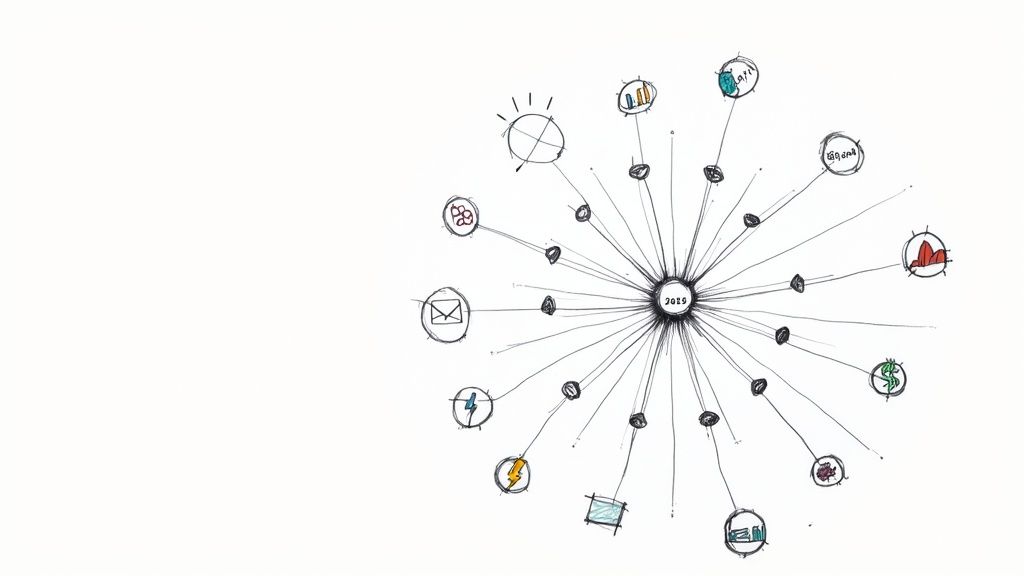Think of an email domain reputation checker as a tool that gives your domain a "health score." It's a lot like a credit score, but for your email sending practices. This score tells Internet Service Providers (ISPs) how trustworthy you are, and it's the single biggest factor in deciding whether your emails hit the inbox or get dumped in the spam folder.
If you're serious about email outreach or marketing, keeping a close eye on this score is non-negotiable.
Why Your Domain Reputation Dictates Inbox Placement

Here's a simple way to look at it: your email domain is your digital passport. Every single time you send an email, big ISPs like Gmail and Outlook are the border agents. They flip open that passport and check for stamps of approval.
Your domain reputation is just the collection of all those stamps, built up over time based on how you send emails. A good reputation tells them you're a legitimate sender, and your messages are actually wanted.
On the flip side, a poor reputation is a massive red flag. It screams that your emails might be spammy, unwanted, or worse, malicious. When ISPs see that, they do their job—they protect their users by filtering you straight to spam or blocking you completely. Suddenly, all your hard work on outreach campaigns and newsletters becomes invisible.
The Core Factors That Shape Your Score
So what are these "stamps" that ISPs are looking for? While every provider has its own secret sauce, they all monitor a few key signals to figure out if you're a good sender. Getting a handle on these is the first real step to controlling your deliverability.
Here are the big ones:
- Spam Complaint Rate: This is a killer. It's the percentage of people who hit the "spam" button on your emails. To ISPs, this is the most direct feedback they can get.
- Authentication Records: Having your SPF, DKIM, and DMARC set up correctly is like showing up with a government-issued ID. It proves you are who you say you are.
- Blacklist Status: If your domain ends up on a major blacklist, it's game over for a while. This is a huge blow that can cause widespread delivery failures.
- Sending Volume and Consistency: Suddenly blasting out 100,000 emails from a brand-new domain looks incredibly suspicious. ISPs want to see a predictable, steady sending pattern.
- Subscriber Engagement: Are people actually opening and clicking your emails? High engagement is a massive positive signal. It tells ISPs that your recipients find your content valuable.
How Reputation Is Measured
To make sense of all these factors, platforms have created scoring systems. The most well-known metric is probably Sender Score by Validity, which grades domains and IPs on a scale from 0 to 100.
Think of it this way: a score between 85 and 100 is considered great. You're in the clear, and your emails have a much better chance of sailing past spam filters. But if your score dips below 70, you're likely running into serious deliverability problems.
This system is so important because it's not a one-time check; it reflects your behavior over the long haul. It rewards you for being a consistent, responsible sender who plays by the rules. You can find some more great insights into how Sender Score works and its impact on email globally.
Picking the right email domain reputation checker isn't about chasing the highest score. It’s about finding the tool that hands you actionable data you can actually use.
Some tools give you a quick, high-level snapshot, which is fine for a quick glance. Others dig deep and pull granular insights straight from the source. The trick is to match the tool's capabilities to your sending volume and what you're trying to accomplish.
For instance, a small business just getting its feet wet with email marketing has very different needs than a high-volume sender managing massive campaigns. Your choice will be the difference between getting a simple vanity score and getting deep, diagnostic info that actually improves your inbox placement.
Free ISP Tools vs. Paid Platforms
The first fork in the road is deciding between free, provider-specific tools and a comprehensive paid platform. Honestly, both have a place in a solid email strategy.
Free tools from the big Internet Service Providers (ISPs) are gold because they give you data straight from the horse's mouth. These aren't third-party estimates; they're direct reports on how that specific ISP sees your domain.
- Google Postmaster Tools (PMT): Absolutely essential if you send any significant volume to Gmail users. It gives you direct feedback on your domain and IP reputation, spam complaint rates, and authentication status—all from Google's perspective.
- Microsoft Smart Network Data Services (SNDS): This is Microsoft's version for Outlook.com and other Microsoft inboxes. It’s crucial for keeping an eye on things like spam trap hits within their network.
These tools are powerful, but they’ve got blinders on. They only show you data for their own ecosystems. A perfect reputation with Gmail doesn't automatically mean you have one with Outlook. To see the whole playing field, you'll need to look beyond these freebies.
What to Look for in a Comprehensive Checker
When you’re ready for the full picture, a paid or more advanced email domain reputation checker is the way to go. These tools pull data from multiple sources, giving you a much broader understanding of where you stand across the entire email landscape.
It's wild how sensitive the spam thresholds are. Both Google and Yahoo will often penalize senders with spam rates creeping above 0.3%. To stay in their good graces, you really want to keep that number below 0.1%. This isn't just a guess; it's based on their analysis of billions of daily messages, which shows just how much user feedback drives your score. You can discover more insights about domain reputation on Powerdmarc.com.
So, what should you look for in a more advanced tool? Here are the non-negotiables:
- Blacklist Monitoring: Does the tool check your domain and IP against the most influential real-time blacklists (RBLs)? Getting listed is a nightmare, so proactive alerts are a lifesaver.
- Authentication Health Checks: It absolutely has to validate your SPF, DKIM, and DMARC records. More importantly, it needs to flag any setup errors that are silently tanking your deliverability.
- Spam Trap Data: The best tools will give you some insight into whether you're hitting spam traps. Hitting these is one of the fastest ways to completely torch your reputation.
- Historical Trend Data: A single score is just a snapshot in time. You need a tool that shows you how your reputation has shifted over weeks or months. This helps you connect a sudden dip in your score to a specific email campaign you sent out.
Comparing Popular Domain Reputation Checkers
With so many options out there, it can be tough to figure out where to start. Some are free and give you a great starting point, while others are paid platforms designed for serious senders who need all the details.
This table breaks down some of the most common tools to help you see what might be the best fit.
Ultimately, the goal is to find a checker that helps you not just check email sender reputation but also gives you a clear, actionable punch list of what to fix. For a deeper dive, read our guide on the different ways to check email sender reputation.
Decoding Your Reputation Score and Reports

Running a check and getting a score is just the opening scene. The real story unfolds when you dig into the report from your email domain reputation checker. This is where you get the roadmap to understanding how mailbox providers like Gmail and Outlook actually see you.
Think of it like this: your score is the final grade, but the report is the detailed feedback explaining why you got that grade. It demystifies the numbers, turning abstract metrics into a clear picture of your sending health. This is where you connect the dots between your actions and your inbox placement.
Key Metrics You Cannot Ignore
When you open up one of these reports, your eyes will probably jump to a few core metrics. These are the vital signs of your entire email program. Getting a handle on what they mean—and what "good" versus "bad" looks like—is essential for spotting problems before they completely derail your efforts.
Start by focusing on these critical data points:
- Spam Complaint Rate: This one is huge. It’s the percentage of people who hit the "spam" button on your email. For mailbox providers, this is the most direct and damaging form of negative feedback you can get. A good rate is below 0.1%; anything creeping up toward 0.3% is a massive red flag.
- Blacklist Status: Your report will show if your domain or sending IP is on any major blocklists. Even a single listing can absolutely cripple your deliverability, so this needs to be spotless.
- Authentication Alignment (SPF/DKIM/DMARC): This isn't just a simple pass/fail. A good report confirms your authentication records are not only present but also correctly configured and aligned. Any failure here makes you look suspicious to receivers.
- Engagement Metrics: While not always a direct score, many tools infer engagement from your sending patterns. Consistently low open and click rates are a quiet signal to ISPs that your content isn't wanted, which slowly chips away at your reputation over time.
Connecting the Report to Real-World Scenarios
The real power of these reports is using them as a diagnostic tool. Your reputation score doesn't just drop for no reason; the report will almost always point you to the culprit.
Let's walk through a common scenario I've seen countless times.
Imagine your deliverability suddenly tanks. You run a reputation check, and your score has plummeted from a healthy 95 down to 72. You open the detailed report and, boom, there it is: your spam complaint rate spiked to 0.4% right after your latest newsletter went out.
The report gives you the "what"—a high complaint rate. Now you can investigate the "why." Did you email an old, unengaged segment of your list by mistake? Was the subject line a little too clickbaity and misleading? This is how a report turns a crisis into a solvable problem.
Similarly, if you spot a new blacklist entry, you can immediately find out which list it is and start investigating why you were added. It might be from hitting a spam trap, which is a clear sign your list hygiene practices need an urgent overhaul.
By breaking down the data, you can create a targeted action plan instead of just guessing what went wrong. For a deeper dive into interpreting these numbers, our guide on how to check your email spam score offers some extra context.
A Practical Plan to Fix a Low Domain Score
Discovering your domain has a low reputation score can feel like a punch to the gut. But it's not a permanent stain on your record. Think of it as a clear, flashing sign that something in your email strategy is broken.
With a methodical approach, you can repair the damage and rebuild that critical trust with Internet Service Providers (ISPs). The whole recovery process really boils down to three core pillars: authentication, list hygiene, and smart sending practices.
Solidify Your Authentication
First things first: you need to prove you are who you say you are. This is where email authentication comes into play. Protocols like SPF (Sender Policy Framework), DKIM (DomainKeys Identified Mail), and DMARC (Domain-based Message Authentication, Reporting, and Conformance) are completely non-negotiable in today's email world.
They act as your domain's digital signature, assuring ISPs that an email from you is legitimate and not some spammer's phishing attempt. Without them, you look suspicious right out of the gate. Setting these records up is the foundational fix for a damaged reputation.
- SPF tells the world which IP addresses are actually allowed to send emails for your domain.
- DKIM adds a cryptographic signature to your emails, proving the content hasn't been messed with in transit.
- DMARC ties them together and tells receiving servers what to do if an email fails the SPF or DKIM checks.
Putting all three in place is a powerful signal to ISPs that you take email security seriously. It’s a massive step toward getting back in their good graces.
Overhaul Your List Hygiene
Once your authentication is locked down, the focus shifts to who you're sending to. I've seen it time and time again: a dirty email list is the number one cause of a tanking reputation. Sending emails to invalid addresses, subscribers who never open anything, or—worst of all—spam traps is like intentionally crashing your car.
Spam traps are a particularly nasty problem. These are email addresses created by ISPs and blocklist providers specifically to catch senders with sloppy list management. Hitting just a handful of these can get you blacklisted fast.
The numbers don't lie. Industry benchmarks show that triggering spam traps can land you on over 200+ blocklists, causing your deliverability to plummet by more than 30%. On top of that, a study from Valimail highlights that spam complaint rates above just 0.3% will cause ISPs to filter your messages aggressively. For context, the best senders keep their rates well below 0.1%.
Regularly scrubbing your list with an email validation service is essential. It weeds out the invalid, misspelled, and disposable addresses before they can cause a hard bounce or hit a trap. It's also smart to implement a "sunset policy" to remove subscribers who haven't engaged with your emails in months. This not only cleans your list but also immediately boosts your engagement metrics. For more on this, we have a whole guide on how to avoid spam filters.
Using a domain reputation checker is pretty straightforward, and it's designed to give you quick insights. This infographic breaks down the typical workflow.

This simple three-step process—input, analysis, and results—is the core of how you can quickly get a pulse on your domain's health and spot the most critical issues.
Warm Up Your Domain
If your reputation is in really bad shape, or you’re starting with a brand new domain, you can't just jump back to sending massive campaigns. You have to "warm up" your domain or IP address first.
This involves starting with a very small volume of emails—sent only to your most engaged subscribers—and then gradually increasing that volume each day. It’s a slow, methodical process that shows ISPs you're a predictable and responsible sender.
You’re essentially rebuilding their trust, demonstrating that your emails are wanted and legitimate. A typical warming schedule might take several weeks, but that patience pays off big time with much better long-term deliverability.
Proactive Strategies to Keep Your Reputation Squeaky Clean
Alright, so you've used an email domain reputation checker, dug into the issues, and put in the work to get your score back on track. Great. But the job isn't done. Now, we switch gears from reactive fire-fighting to proactive, long-term maintenance.
Keeping a high reputation is all about consistency. It’s like preventive care for your deliverability. You wouldn't wait for your car's engine to seize before getting an oil change, right? Same idea here. We're building predictable, positive sending habits that mailbox providers (like Gmail and Outlook) learn to recognize and trust over time.
Settle Into a Consistent Sending Schedule
Internet Service Providers (ISPs) are basically creatures of habit. They get really suspicious of erratic behavior. They keep a close eye on how many emails you send and how often, looking for patterns that scream "legitimate sender." A domain that’s been quiet for months and then suddenly blasts out 50,000 emails is a massive red flag.
The fix? Find a rhythm and stick to it. If you have a weekly newsletter, send it around the same day and time each week. This consistency helps ISPs see you as a reliable sender, not some spammer who just hijacked a dormant domain.
A steady sending cadence is a huge trust signal for mailbox providers. It shows them your email activity is planned, intentional, and part of a real business operation. That predictability is your golden ticket to the inbox.
Master Your Email Content
What's inside your email matters—a lot. ISPs use some pretty smart algorithms to scan everything from your subject line to the links in your signature, hunting for anything that looks spammy.
Here’s how to keep your content clean and inbox-friendly:
- Ditch the Spam Trigger Words: You know the ones. Words like "Free," "Cash," "$$$," or "Guaranteed" are old-school spam filter bait. Get creative and find other ways to convey value.
- Balance Your Text and Images: Emails that are just one giant image are a classic spammer move. Always aim for a healthy text-to-image ratio. A good rule of thumb is to make sure your core message is clear even if the images don't load.
- Link to Reputable Places: Be mindful of where you're sending people. Only link out to trusted, secure websites. Linking to shady domains can tarnish your reputation by association.
It also helps to see how your email efforts fit into the bigger picture. If you're looking to frame your campaigns within a larger plan, this digital marketing strategy template provides a really useful structure.
Get Your Subscribers to Engage
At the end of the day, the most powerful signal you can send to ISPs is that real people actually want your emails. Positive engagement—we're talking opens, clicks, forwards, and especially replies—tells providers that your content is valuable.
So, don't be afraid to encourage these interactions. Ask a question to get a reply. Use a super clear call-to-action to earn that click. This positive feedback loop is absolutely essential for building and maintaining a stellar reputation.
If you want to go deeper on this, check out our complete guide to improving email deliverability.
Common Questions About Email Reputation

Even with the best tools in your arsenal, navigating the nuances of email reputation can leave you with a few lingering questions. It's a complex world, for sure. So, let's clear the air and tackle some of the most common ones I hear from people trying to get their deliverability on the right track.
How Long Does It Take to Fix a Bad Reputation?
This is the big one, and the honest answer is: it's a marathon, not a sprint. How long it takes to repair a damaged domain reputation really boils down to how bad the damage is and how disciplined you are with your fixes.
If you're dealing with minor issues, like a one-off campaign that caused a temporary spike in bounce rates, you might see positive changes in just a couple of weeks. But for the heavy-duty problems—like getting slapped on a major blacklist—you need to be prepared for a longer haul. Realistically, you're looking at anywhere from 1 to 3 months of consistent, positive sending behavior.
That means no cutting corners. You have to be diligent about proper authentication, keep your lists squeaky clean, and, most importantly, send content that your audience genuinely wants to open.
Patience is probably the most underrated tool in deliverability. You're essentially rebuilding trust with mailbox providers like Gmail and Outlook. They need to see a sustained pattern of good behavior before they'll start routing you back to the inbox consistently.
Can a Domain Have a Better Reputation Than an IP Address?
Absolutely. In fact, it happens all the time. Think of it this way: your domain reputation is tied to your brand (@yourcompany.com), while your IP reputation is linked to the specific server sending the email. They're related, but not the same thing.
This difference becomes crystal clear if you're using a shared IP address from an email service provider (ESP). You could be doing everything right, but if another sender on that same IP is blasting out spam, it can tank the IP's score. It's a classic case of guilt by association. This is exactly why serious, high-volume senders often invest in a dedicated IP—it gives them complete control over their sending environment.
Will Switching My Email Provider Affect My Reputation?
When you change your ESP, the main thing you're impacting is your IP reputation, not your domain reputation. Your domain's history—all the good and bad—is attached to you, and it follows you wherever you go.
The catch is that your new provider will almost certainly have you sending from a new IP address. This means you absolutely have to go through a proper IP warming process. You're essentially introducing a new server to the world, and you need to build up its sending history from scratch.
Your strong domain reputation will definitely help speed this along, but you can't just skip the warming phase. Make sure your new provider is on top of getting all your authentication records configured correctly from day one, too. A clean start is critical.
And don't forget that keeping your subscriber lists healthy is a non-negotiable part of this process. For more on that, check out our guide on the importance of email verification.
Ready to take control of your cold outreach and maintain a stellar reputation? PlusVibe offers advanced deliverability controls, automated email warming, and built-in validation to ensure your messages hit the inbox every time. Discover how PlusVibe can scale your outreach today.














































.jpeg)


.png)























































